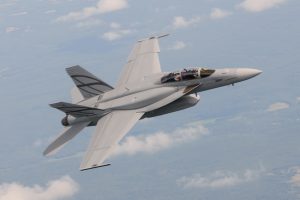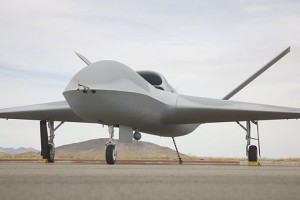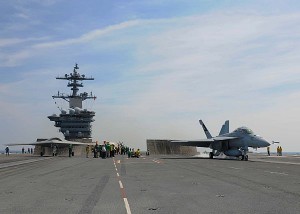 There should be little mystery behind Northrop Grumman’s recent decision to withdraw from the MQ-25 Stingray Program.
There should be little mystery behind Northrop Grumman’s recent decision to withdraw from the MQ-25 Stingray Program.
As the requirements have trickled out, the Stingray has started to look very much like an unmanned F-18 variant. And that’s great, because an F-18 variant would help the Navy focus on integrating a pedestrian unmanned platform into the carrier air wing without the distraction of integrating a radical airframe, entirely new gear, new training pathways, new operational parameters and on and on into a carrier and an air wing. An F-18 variant is the only easy route to getting an operational platform on a carrier deck by ’19, as well, and it removes the F-18 line closure threat from the next Presidential election (Now, this isn’t to dismiss the chances of a successful bid from General Atomics, but, to win against an F-18 variant, General Atomics will need to offer an incredibly low unit price–which would also be great, but for different reasons.)
If an F-18 variant looked like a designated winner to Northrop Grumman, sticking with the Stingray would mean that Northrop Grumman had basically decided to compete with itself. You see, Northrop Grumman is already on the F-18 team, and earns shareholders a tidy profit for doing so. Forging ahead on the Stingray, using Northrop Grumman’s existing UCLASS/UCAS airframe, would force an expensive redesign and make Northrop Grumman shave so much margin off their platform to compete with F-18 variants, they’d never make a profit. And, just to make the deal really super-palatable, Northrop Gruman would need to consider the likelihood an irked Boeing would find another partner to provide the Stingray parts Northrop is already supplying, ultimately killing off Northrop’s profitable F-18 business.
James Bach over at the Washington Business Journal explained Northrop Grumman’s happy relationship with the F-18 program back in 2016:
“F-18 has been a great program for this company and continues to be,” CFO Ken Bedingfeld told investors this week at Citi’s Industrials Conference in Boston, adding that it’s also a “nice margin generator.”
He also said that Northrop (NYSE: NOC) still generates about $600 million a year in revenue producing F-18s at facilities in El Segundo, California. Northrop shares work with The Boeing Co. (NYSE: BA), handling about 40 percent of its production.
Treasurer Stephen Moius elaborated further on those figures, explaining that about $400 million of those sales come from the production of F/A-18E/F Super Hornets, a multirole strike aircraft. The other $200 million comes from EA-18G Growlers.
So it looks to me that Northrop Grumman made the smart choice of keeping the existing business and, hell, they probably pressed their competitive advantage in the unmanned space to get a larger slice of the potential Stingray platform. Everybody wins!
 Stingray Will Ride An F-18 Chassis
Stingray Will Ride An F-18 Chassis
The Boeing MQ-25 Stingray may end up looking quite a bit different from it’s F-18 combat jet forebears, but, from the few basic stats available to the public and the aggressive timeline articulated by Navy leadership, it’s pretty clear that the Navy wants an MQ-25 Stingray that is very much like an established, known F-18.
There’s quite a few items that point towards an F-18 variant:
Timeline: CNO Richardson wants Stingray operational by ’19, This, to me, suggests the Stingray can’t stray too far from an operational platform–all the maintenance, operational envelope work and training has got to be largely already in place TODAY. And then there’s the perennial fear of having a large defense production line closing out just before a Presidential election–an F-18 Stingray variant would remove that canker quite quickly. And if you look at this report from USNI, let’s also note that the Ford Class’s launch and recovery software takes years to accommodate new weight profiles, and, as it is, USS Ford won’t be throwing F-18s with large Cobham buddy tanks off the flight deck until, oh, gosh, ’19 (oh, hey that’s interesting timing, no?). If we want the Stingray to work by ’19, then it must align with the Ford’s existing launch and recovery programming.
Now, if General Atomics–the maker of the Ford’s launch and recovery systems–has a good idea of exactly what particular airframe structural and weight parameters EMALs and AAG accept, then that makes the GA offering potentially far more interesting.
Capability: The stats I’ve seen reported suggest existing late-model F-18s already carry about 15,000 lbs internally and about 10,000 lbs externally. I’m doing this on the back of an envelope, but, overall, there’s about 30,000 lbs of payload capability, and that’s not a huge delta between the publicly articulated Stingray requirements. Removing the pilot and some sensors would certainly allow an unmanned F-18 variant to meet the publicized Stingray requirements–while possibly maintaining some ISR or self-defense capes. Barring some crazy surprise in the RFP requirements, the Next-Gen Flight III F-18 Boeing has been shopping looks awfully, awfully capable of meeting base Stingray requirements.
Airframe Tinkering: Boeing has a full stack of F-18 variants all ready to roll. We’ve all pretty much forgotten all about Boeing’s mysterious, noseless F-18 that Bill Sweetman found sitting in the Boneyard back in 2014. Might those experiments lend themselves to a modular design (nose-swapping will happen!) or some variation on the F-18 chassis that shows a different profile? Or can a refueling-oriented riff off the Block III upgrade suffice? Could older airframes be modified to support unmanned tanking duties? I don’t know, but….there just seem like there are a lot of neat ways at a lot of different price points available to help Boeing get the existing F-18 airframe to serve as a viable unmanned tanker–and any bidder going against Boeing has to address each cost option, which just ain’t fun.
Software/Flightware: Boeing has plenty of experience with autonomous flight systems. If Northrop Grumman is on the team, then Boeing has a mountain of expertise and carrier-relevant past performance available to draw from. The F-18 was a risk reduction platform for Northrop’s carrier UAV prototype, the F-18 Magic Carpet system is making steady strides towards supporting autonomous landings, and Boeing’s work on the QF-16 drone conversion program all help build the buyer’s confidence.
Comparatively, General Atomics has little relevant experience with airframes aboard carriers.
 The Stingray Is Interim:
The Stingray Is Interim:
It is time to make peace with the idea that the MQ-25 Stingray is likely going to be a low-cost and an appropriately interim platform. And that platform–as I have written before–will be:
“…a low-end, bare-bones platform, focused on three things: 1) Integrating UAVs into carrier operations; 2) Demonstrating operational feasibility in the field; and 3) Testing advanced operational concepts. If done right, the Navy is going to lose some of these vehicles, so they should plan accordingly and buy the cheap model.
Sure, any new and exotic airframe is hard to resist, but if the Navy is going to invest a single shekel in pushing the limits of already well-proven aerodynamic principles to obtain anything other than fewer launch/landing cycles through greater payload/endurance, then, well, they’re doing it wrong.
For this program, the U.S. Navy needs to be laser-focused on getting the computer, flight AI and electrical systems optimized for carrier operations, demonstrate that these things are sailor-proof and figure out an operational path for these vehicles in what will be a rather sporty electromagnetic environment.
Everything else comes second.”
Northrop Grumman recognized the Navy’s desire for a speedily-fielded platform and, along with the service’s particular demand for what are essentially “off the shelf” unmanned solutions, the company leadership looked hard at the business case and found one. There’s no shame in joining the likely winner, enjoying the high margin work it brings in, and keep the intellectual powder dry for the next step–unmanned carrier and ship-based warfighter platforms and high-end EW/Comms/ISR birds.
The Stingray’s progress towards reality has been a rocky road. But I think the Navy is making a good choice here–preserving the option of making incremental improvements on an existing airframe while forcing all others into an aggressive cost shoot-out.
So…with Northrop Grumman out, it’s now a Boeing/General Atomics contest. But who knows. Maybe Lockheed will surprise us all!
